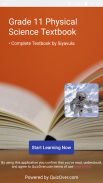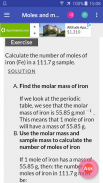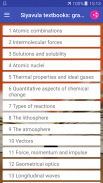






Grade 11 Physical Science Textbook, Test Bank

Grade 11 Physical Science Textbook, Test Bank açıklaması
Siyavula Textbooks: Grade 11 Physical Science
* Complete Textbook by Siyavula
* Multiple Choices Questions (MCQ)
* Essay Questions Flash Cards
* Key-Terms Flash Cards
Powered by QuizOver.com the leading online quiz creator
https://www.quizover.com
Atomic combinations
Introduction
0.1 Atomic combinations
0.2 Why do atoms bond?
0.3 Energy and bonding
0.4 What happens when atoms bond?
1 Covalent bonding and lewis notation
2 Electronegativity and ionic bonding
3 Metallic bonding
4 Writing chemical formulae
5 Shapes of molecules
6 Oxidation numbers
7 Energy changes in chemical reactions
Intermolecular forces
Introduction and types of intermolecular forces
1 Understanding intermolecular forces
2 Liquids
Solutions and solubility
Introduction and key concepts
1 Solubility
Atomic nuclei
Introduction
1 Radioactivity and types of radiation
2 Sources of radiation
3 Half-life
4 Dangers and uses of radiation
5 Nuclear fission and fusion
Thermal properties and ideal gases
Boyle's law and charle's law
1 Ideal gas law and general gas equation
Quantitative aspects of chemical change
Moles and molar mass
1 Stoichiometry and composition
Types of reactions
Acid-base reactions
1 Redox reactions
2 Addition, elimination and substitution reactions
The lithosphere
Introduction
1 Mining and mineral processing
2 Energy resources
The atmosphere
Composition and structure
1 Greenhouse gases and global warming
Vectors
Introduction and key concepts
1 Mathematical properties
2 Adding and subtracting vectors
3 Components
Force, momentum and impulse
Introduction and key concepts
1 Newton's first law
2 Newton's second law
3 Lifts and rockets
4 Newton's third law
5 Different types of forces
6 Forces in equilibrium
7 Forces between masses
8 Momentum
9 Change in momentum
10 Impulse
11 Conservation of momentum
12 Physics in action
13 Torque and levers
14 Summary and exercises
Geometrical optics
Converging lenses
1 Diverging lenses
2 The human eye
3 Telescopes and microscopes
Longitudinal waves
Introduction and key concepts
1 Sound waves, seismic waves and graphs of motion
Sound
Introduction and key concepts
1 Applications
The physics of music
Standing waves in string instruments
1 Standing waves in wind instruments
2 Resonance and sound quality
Electrostatics
Coulomb's law
1 Electric fields around charges
2 Electrical potential energy
3 Capacitors
Electromagnetism
Magnetic field associated with a current
1 Current induced by a changing magnetic field
2 Transformers
3 Motion of a charged particle in a magnetic field
Electric circuits
Ohm's law
1 Resistance
2 Parallel and series networks
Electronic properties of matter
Conductors, insulators and semi-conductors
1 Intrinsic properties and doping
2 The p-n junction
Siyavula Ders Kitapları: 11. Sınıf Fizik Bilimleri
* Siyavula tarafından Komple Ders Kitabı
* Çoklu Seçimleri Sorular (MCQ)
* Deneme Soruları Flaş Kartları
* Anahtar Terimler Flaş Kartları
QuizOver.com önde gelen online bilgi yarışması yaratıcısı tarafından desteklenmektedir
https://www.quizover.com
atom kombinasyonlar
Giriş
0.1 Atom kombinasyonları
0.2 neden atomuna bağ mi?
0.3 Enerji ve yapıştırma
0.4 Ne zaman atomlar bağ olur?
1 kovalent bağ ve Lewis notasyonu
2 Elektronegativite ve iyonik bağ
3 Metal bağlama
4 Yazma kimyasal formülleri
Moleküllerin 5 Şekiller
6 Yükseltgenme sayıları
kimyasal reaksiyonlarda 7 enerji değişimleri
Moleküller arası kuvvetler
Giriş ve moleküller arası kuvvetler türleri
1 anlama moleküller arası kuvvetler
2 Sıvılar
Çözümler ve çözünürlüğü
Giriş ve temel kavramlar
1 Çözünürlük
atom çekirdeklerinin
Giriş
1 Radyoaktivite ve radyasyon tipleri
radyasyon 2 kaynakları
3 Yarı ömür
4 Tehlike ve radyasyon kullanımları
5 Nükleer fisyon ve füzyon
Isıl özellikler ve ideal gazlar
Boyle yasası ve Charle'nın kanunu
1 İdeal gaz yasası ve genel gaz denklemi
Kimyasal değişim nicel yönleri
Mol ve molar kütle
1 stokiyometrisi ve bileşimin
reaksiyon tipleri
Asit-baz reaksiyonları
1 Redoks reaksiyonları
2 ilavesi, yok edilmesi ve yer değiştirme tepkimeleri
litosfer
Giriş
1 maden işleme
2 Enerji kaynakları
Atmosfer
Bileşim ve yapı
1 Sera gazları ve küresel ısınma
Vektörler
Giriş ve temel kavramlar
1 Matematiksel özellikleri
2 vektörleri ekleme ve çıkarma
3 Bileşenleri
Kuvvet, momentum ve impuls
Giriş ve temel kavramlar
1 Newton'un birinci yasası
2 Newton'un ikinci yasası
3 Asansörler ve roket
4 Newton'un üçüncü yasası
kuvvetlerin 5 Farklı tipte
dengede 6 kuvvetler
kitleler arasındaki 7 Kuvvetler
8 Momentum
ivme 9 Değişim
10 Darbe
momentum 11 Korunması
eylem 12 Fizik
13 tork ve kollar
14 Özet ve egzersizler
geometrik optik
yakınsak mercekler
1 taktirde değişik lensler
2 insan gözü
3 teleskoplar ve mikroskoplar
Boyuna dalgalar
Giriş ve temel kavramlar
1. Ses dalgaları, deprem dalgaları ve hareket grafikleri
Ses
Giriş ve temel kavramlar
1 Uygulamalar
müziğin fiziği
yaylı çalgılar kararlı dalgalar
Rüzgar aletleri 1 durağan dalgalar
2 Rezonans ve ses kalitesi
Elektrostatik
Coulomb yasası
masrafları ile 1 Elektrik alanları
2 Elektriksel potansiyel enerji
3 Kondansatörler
elektromanyetizm
bir akım ile ilişkili Manyetik alan
değişen bir manyetik alan tarafından indüklenen 1 Mevcut
2 Transformatörler
Manyetik bir sahada yüklü bir partikülün 3 Hareket
Elektrik devreleri
Ohm kanunu
1 Direnç
2 Paralel ve seri ağlar
Maddenin Elektronik özellikleri
İletkenler, izolatörler ve yarı iletkenler
1 iç özelliklerini ve doping
2, p-n eklemi



























